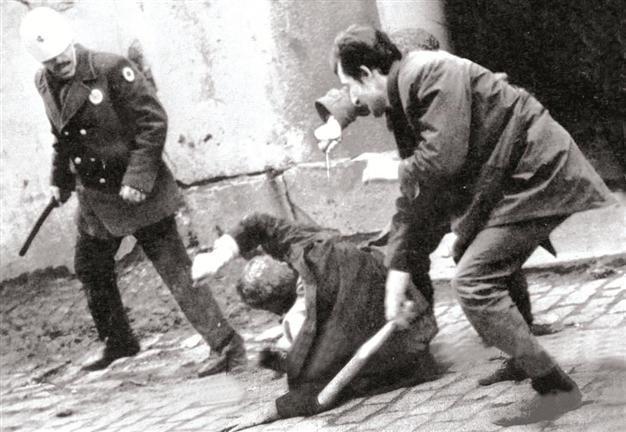Protesting, alla turca, past and present
BELGİN AKALTAN - belgin.akaltan@hdn.com.tr
 The Turkish style of protesting includes, as seen last week, painting city stairs in rainbow colors… During the Gezi Park incidents, we saw a variety of protests. The standing man, of course; and Guy Fawkes masks, penguins, banging pots and pans, switching lights on and off…
The Turkish style of protesting includes, as seen last week, painting city stairs in rainbow colors… During the Gezi Park incidents, we saw a variety of protests. The standing man, of course; and Guy Fawkes masks, penguins, banging pots and pans, switching lights on and off… I’m trying to find a pattern in these alla turca ways of protesting. Could the code of popular Turkish protests be “not doing something” instead of “going out and actively doing something?”
Maybe the common denominator of any widespread Turkish protest is being passive. Instead of getting organized for a collective act, passive, inactive, anonymous, non-attention-grabbing, low-profile, easy and lazy methods of protesting are popular with us. Getting up from your couch in the comfort of your home and switching on and off your lights is not dangerous; no organizational activity or preparation is involved except looking at your watch.
Standing man: Just put your hands in your pockets and stare blankly. How much more suitable can that be for us? You don’t have to do anything. Just stand still. I’m not saying this way of protesting is not effective. On the contrary, it is clever and very effective. I’m questioning why it became instantly popular in Turkey. Well, precisely because it suits our inertia.
Guy Fawkes masks are good because it hides your identity. Penguins are witty. Banging pots and pans do not require much of an effort or groundwork. Just look at your watch, go to your kitchen, pick two pans, open your window and start banging. Of course the Gezi spirit and Gezi protests were contrary to all the above... They were exceptional…
There was another legendary protest which occurred in 1969 – when Turkish students demonstrated against the visit of the American 6th Fleet. They pushed American marines into the sea at the Dolmabahçe quay in Istanbul. That was unheard of before…
Now I will have to make a big full stop here.
While I was collecting data about the 1969 incidents, I came across the following text and the synopsis of the article had to be completely changed. I was going to write about different protests in Turkey, about Greenpeace Turkey’s creativity, about how students throwing eggs were punished, how students holding posters in Parliament were dealt heavy sentences. Other ways of protests could include throwing your shoe during a press conference and/or turning on your car emergency lights and dancing to the music on the radio to protest oil prices…
They have all been put on the back burner to make room for this: The Bloody Sunday (1969) entry on the Turkish version of Wikipedia, with my free translation.
Bloody Sunday (Turkish: Kanlı Pazar) is the name given to the incidents that occurred on Feb. 16, 1969, in Istanbul’s Taksim Square where youth organizations held a demonstration to protest the visit of the American 6th Fleet.
After smaller protests, students and labor organizations decided to organize an anti-American protest in Istanbul. The required permit for the demonstration was obtained from the Istanbul Governor’s Office.
Tension had reached its peak in the days leading to the demonstration because on Feb. 14, after Friday prayers, a rally was held led by right-wing associations. In that rally, people were called to gather to give “the necessary lesson to communists” at the anti-American march to be held two days later.
While demonstrators on the day of Feb. 16 started gathering at Beyazıt Square, right-wing people responding to the call to “give a lesson to the communists” arrived at Taksim Square. They performed a collective prayer there and started waiting with stones and sticks in their hands.
Youth organizations started their march from Beyazıt Square. Passing through Sultanahmet, Sirkeci, Eminönü, Karaköy and Dolmabahçe, they were blocked by police while entering Taksim. Police allowed small groups to enter the square. Those who were able to pass were attacked by rightists with sticks, stones and knives.
Attackers chanting “Allah is great” violently beat up the demonstrators. During the incidents, two young people, Ali Turgut Aytaç and Duran Erdoğan, were stabbed to death. It was observed that police did not exactly do much to stop the attackers.
The next day, a photo printed on the front page of daily Hürriyet showed the moment Ali Turgut Aytaç was stabbed. The picture clearly showed that a riot police officer was just standing there. This created a huge reaction.
All political parties except for the ruling Justice Party (AP) wanted the Interior Minister Faruk Sükan to resign. Despite this, Sükan blamed the leftist students and stated that police were conducting their normal duties. Only a limited investigation was made…
Oh my God, just change the names and the date; the situation is identical to the Turkey of 2013. Is that it? Have we not learned anything since 1969? How come such a similar scenario plays out over and over again? Are we dumb? Are they dumb?
Is it in our genes to beat up protestors? And be beaten up while the police are watching? Encouraging attackers? Hating all kinds of demonstrators?
No wonder we have a very limited culture of protest. Who would dare go out on the street?
https://twitter.com/belginakaltan











